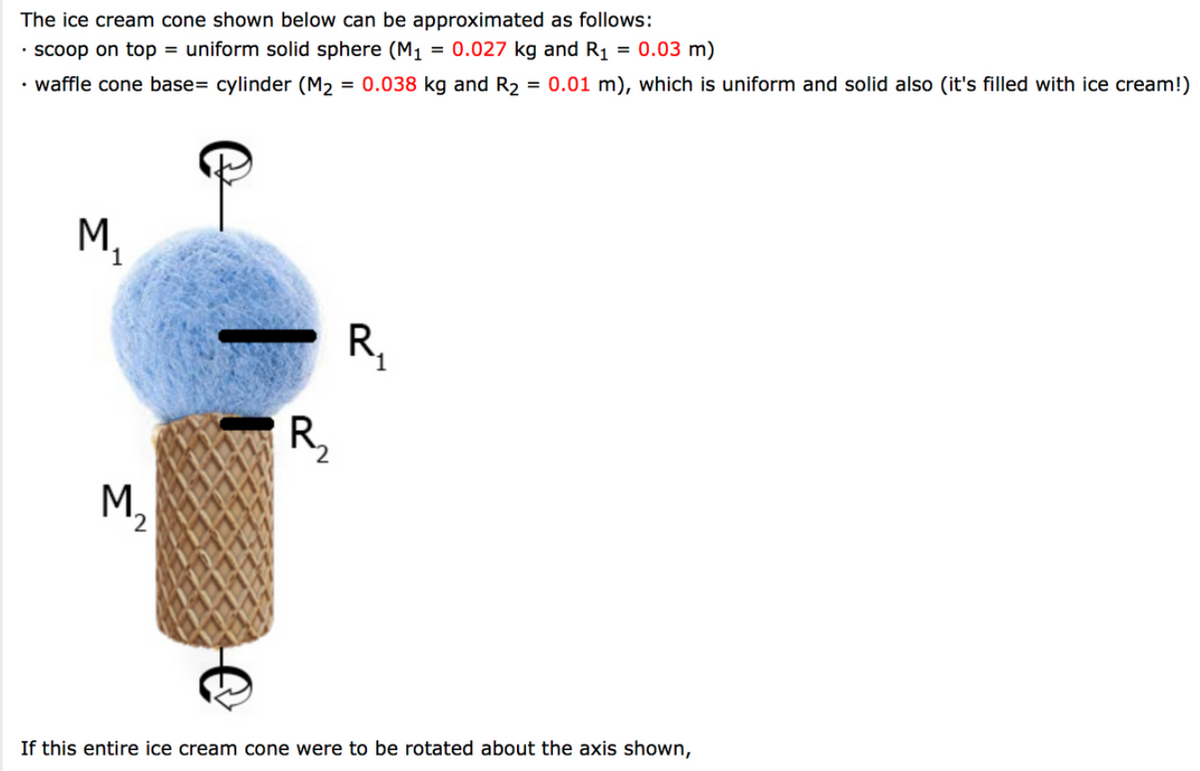b.) Your friend Bob proposes that you can do this calculation more easily. He condenses the entire ice cream cone into a point mass located at the its center of mass, then uses the point mass formula (I=mr²). What would be the distance "r" that he would use, and the rotational inertia that would result from his calculation? r = X kg-m2 Is Bob's method correct? I = no; you need to use the object's exact shape in your "I" calculations
b.) Your friend Bob proposes that you can do this calculation more easily. He condenses the entire ice cream cone into a point mass located at the its center of mass, then uses the point mass formula (I=mr²). What would be the distance "r" that he would use, and the rotational inertia that would result from his calculation? r = X kg-m2 Is Bob's method correct? I = no; you need to use the object's exact shape in your "I" calculations
Classical Dynamics of Particles and Systems
5th Edition
ISBN:9780534408961
Author:Stephen T. Thornton, Jerry B. Marion
Publisher:Stephen T. Thornton, Jerry B. Marion
Chapter11: Dynamics Of Rigid Bodies
Section: Chapter Questions
Problem 11.6P
Related questions
Question

Transcribed Image Text:The ice cream cone shown below can be approximated as follows:
· scoop on top = uniform solid sphere (M1 = 0.027 kg and R1 = 0.03 m)
• waffle cone base= cylinder (M2 = 0.038 kg and R2 = 0.01 m), which is uniform and solid also (it's filled with ice cream!)
%3D
M,
R,
R,
M,
If this entire ice cream cone were to be rotated about the axis shown,

Transcribed Image Text:b.) Your friend Bob proposes that you can do this calculation more easily. He condenses the entire ice cream cone into a point mass located at the its
center of mass, then uses the point mass formula (I=mr2).
What would be the distance "r" that he would use, and the rotational inertia that would result from his calculation?
r =
I =
X kg-m2
Is Bob's method correct?
no; you need to use the object's exact shape in your "I" calculations
Expert Solution
This question has been solved!
Explore an expertly crafted, step-by-step solution for a thorough understanding of key concepts.
This is a popular solution!
Trending now
This is a popular solution!
Step by step
Solved in 2 steps

Knowledge Booster
Learn more about
Need a deep-dive on the concept behind this application? Look no further. Learn more about this topic, physics and related others by exploring similar questions and additional content below.Recommended textbooks for you

Classical Dynamics of Particles and Systems
Physics
ISBN:
9780534408961
Author:
Stephen T. Thornton, Jerry B. Marion
Publisher:
Cengage Learning

Principles of Physics: A Calculus-Based Text
Physics
ISBN:
9781133104261
Author:
Raymond A. Serway, John W. Jewett
Publisher:
Cengage Learning

College Physics
Physics
ISBN:
9781938168000
Author:
Paul Peter Urone, Roger Hinrichs
Publisher:
OpenStax College

Classical Dynamics of Particles and Systems
Physics
ISBN:
9780534408961
Author:
Stephen T. Thornton, Jerry B. Marion
Publisher:
Cengage Learning

Principles of Physics: A Calculus-Based Text
Physics
ISBN:
9781133104261
Author:
Raymond A. Serway, John W. Jewett
Publisher:
Cengage Learning

College Physics
Physics
ISBN:
9781938168000
Author:
Paul Peter Urone, Roger Hinrichs
Publisher:
OpenStax College

College Physics
Physics
ISBN:
9781285737027
Author:
Raymond A. Serway, Chris Vuille
Publisher:
Cengage Learning

University Physics Volume 1
Physics
ISBN:
9781938168277
Author:
William Moebs, Samuel J. Ling, Jeff Sanny
Publisher:
OpenStax - Rice University

Physics for Scientists and Engineers, Technology …
Physics
ISBN:
9781305116399
Author:
Raymond A. Serway, John W. Jewett
Publisher:
Cengage Learning